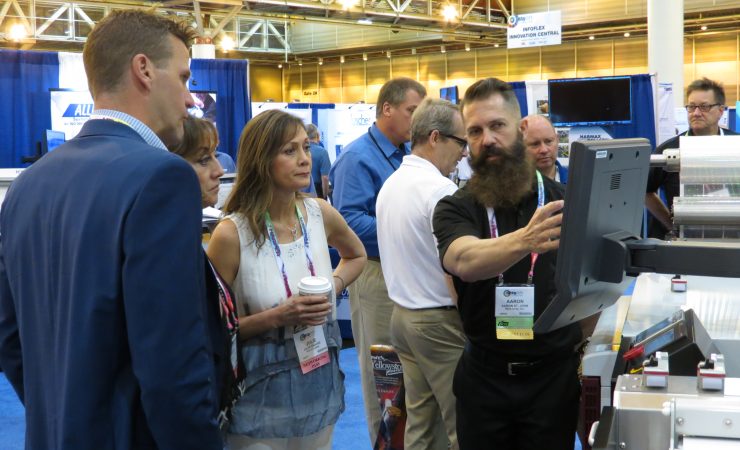The Flexographic Technical Association’s Forum and Infoflex event once again provided the US flexo community with high quality conference sessions combined with plenty of networking opportunities. Michal Lodej attended the event, which this year pitched up in New Orleans, Louisiana.
New Orleans is known as the Big Easy. The name was given to the city by a local journalist commenting on the city’s laid-back atmosphere when compared to the hustle and bustle of the Big Apple. In comparison to European trade shows, Infoflex always has a nice relaxed feel to it, regardless of the city chosen as host. But make no mistake; this is always a place to do business.
Just as the business is conducted in the halls of Infoflex, 6–7 May, the learning takes place at the Forum 5–8 May, which as always had an extensive conference programme, covering many aspects of flexo packaging printing in very fine detail.
One of the most successful and interesting aspects of the Forum is the involvement of students studying graphic arts at degree level. Sessions are full of their findings from the different investigations and experiments they make while studying the printing process.
Emma Linnea Landgren, a third year student at California Polytechnic State University, spoke about her findings on the influence of ink specifications on colour. She said, ‘The problems arise with colour when we mix inks in one environment but once it leaves the lab we don’t know in what environment the ink will be viewed.
‘A logo we want to be printed in three different locations with consistent results would normally be printed with a spot colour, but how do we communicate that colour? Regardless of lighting used we need them to look the same.’
Metamerism is when two colours that are not actually the same (they reflect different wavelengths of light) appear the same under certain lighting conditions. Colours that match under some lights but not others are called metamers.
Apples with apples
The trouble stems from the variety of different processes or systems used in the industry. Different printers have their own workflows, using whichever system works best for them. In colour matching some use colour swathes, some use LAB values or Pantone numbers, some use external suppliers while others use in-house ink labs.
In her experiment, Ms Landgren used two ink sets of eight from two different suppliers, 32 inks in total. She collected the data using a Techkon spectral device and after
comparing LAB values to CFX data values. Found that CXF spectral data however, regardless of which process the printer prefers, will achieve a better visual match across the colour, matching match over the whole spectral curve rather than just a few points.
She concluded, ‘Colour matching is challenging, all stake holders need to communicate properly. Modern technology allows us to communicate better, and the CFX data helps to be much more accurate when looking at colour.’
A fourth year student at California Polytechnic State University, Emily Anderson, gave a presentation on her investigation into how different press variables affect soft touch coatings.
Ms Anderson said, ‘When measuring the samples, factors such as density or friction testing could have worked, however these still don’t measure the sense of touch, which is hard to define, so I instead went for consumer preference instead.’
For the survey, 91 respondents were asked to select a preference from six pairs of samples. The respondents were asked not just to stroke then sample but to handle it as if they were in a shop.
From the results, it was deemed that the choice of substrate was the highest determining factor in providing a soft touch coating with the tint sleeve second and then the choice of anilox roller last.
PET with a 67 shore durometer was preferred more when used with the PP tint sleeve, the two together having a greater effect on the choice of respondents.
She concluded, ‘Soft touch is a cool coating and speciality inks are being used by big brands to make their goods stand out. There is room in this industry to provide packaging for very high end products and so we need to continue to look into this.’

Emily Anderson presented her findings on soft touch coatings and packaging
Pull you fingerprint out
Efficiency and consistency is only achievable with control of the process, and the fingerprint is a key part of that. Anyone with problems with repeatability and consistency will continually struggle; creating a fixed and repeatable process in your press room is of paramount importance.
Mark Mazur, chair of the FIRST Committee, gave a presentation on preparing for a fingerprint. He said, ‘Things in life are not always as cut and dry as you think they should be and a flexo press is no
different. Fingerprinting is the act of benchmarking the performance of a press under a known condition at a given time. A fingerprint never changes, but a press does change over time.
‘For this reason I don’t like the term fingerprinting. I prefer the definition of calibration. The two are synonymous; you’re really calibrating your system. And when you step on a scale in the morning you want that scale to be calibrated properly.
‘To do this, use curve generation programs with all your data points. It is really very simple, ask the questions; where are you, where do you want to be, and then we look at how you get from A to B. But you need to know where you want to be first.
‘If your 50% dots print at 80, you should aim for 68, this figure comes from an ISO standard set long ago. So you need to generate a curve, start with a file with dots from 0 to 100 and you measure where you are, then make the adjustments to get to where you want to be. Don’t think about optimisation, these are parts of your process which should already been defined, determining your preferred operating parameters, then establish the fingerprint. You should not be changing things at this stage.
‘Next is process control. You need to make sure that you control the press and you know the established sets. Don’t think of it linearly; think of it as a circular process, you will always have to come back to optimisation and start the process again, but there should be no surprises when you do your fingerprinting.
‘When you run the fingerprint you measure density and dot gain even though you may already have this information from your optimisation process. If you understand the effects of every variable we can use that information to calibrate the press.’
In the halls
Gama International’s products were shown on both Gama America‘s and Pamarco’s booths. The company introduced its new G32 for viscosity and pH control and correction of water-based adhesives, varnishes and lacquers for converting and laminating applications. It was also a further occasion to show the G31 for the corrugated cardboard market.
Gama also presented, for the first time in the US, its sleeve storage systems. The logistic line consists of three solutions: the manual storage system, the semi-automatic and the fully automatic one. These systems can solve the storage problem for materials such as cylinders, sleeves, film and paper rolls, which need optimal conditions in order to avoid distortion and the following impossibility to use the materials.
BST North America presented a demo unit for 100% inspection; displaying solutions for colour measurement, web guiding, register control, colour management, workflow, automation and BST eltromat’s enhanced partnership with Colorware.
Digimarc was showing visitors its connected packaging technology the Digimarc Barcode. This is a barcode that is invisible to the naked eye, but is still picked up by code scanners. The technology improves the scope for the information available to customers via their smart phones and offers more space to packaging designers who no longer need to use the traditional barcode.
Energy Sciences was talking to customers about its GelFlex-EB ink which the company says can give cost reduction through ink savings, waste savings and productivity gains, combined with better image quality and smaller dots. And all while decreasing emissions by 90%. The ink which is cured by electron beam is virtually solvent free and requires no heat to dry.










